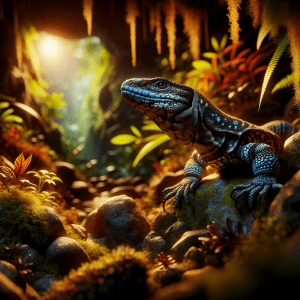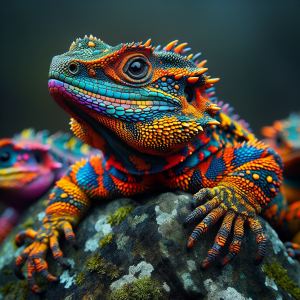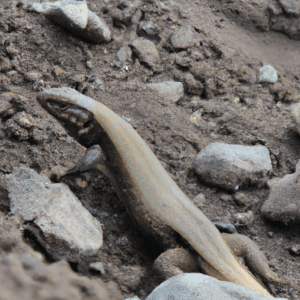Introduction: Conservation Challenges for Andean Lizards
Have you ever stopped to consider the challenges that Andean lizards face in their quest for survival? These remarkable reptiles, native to the Andes mountains, are not only fascinating creatures but also crucial components of their ecosystem. Picture this: a vibrant landscape where Andean lizards play a vital role in maintaining the delicate balance of nature. Their presence contributes to the overall health and diversity of the ecosystem, making them a key species worth protecting.
One interesting fact about Andean lizards is their remarkable adaptations to their high-altitude habitats. These resilient creatures have evolved unique characteristics to thrive in the harsh conditions of the Andes mountains. From their specialized diet to their ability to regulate body temperature at extreme altitudes, Andean lizards are true survivors in a challenging environment.
However, despite their remarkable adaptations, Andean lizards are facing a myriad of conservation challenges that threaten their existence. Habitat loss and fragmentation due to human activities pose a significant threat to these reptiles. As human populations expand and encroach upon their natural habitats, Andean lizards are finding themselves with dwindling spaces to call home.
So, here’s a question to ponder: How can we ensure the survival of these fascinating creatures in the face of mounting conservation challenges? By raising awareness about the importance of Andean lizards and the threats they face, we can take steps towards their protection and preservation. Through conservation efforts, habitat restoration, and sustainable practices, we can work towards securing a future where Andean lizards continue to thrive in their mountainous homes.
Join me on this journey of discovery as we delve deeper into the conservation challenges for Andean lizards and explore ways to support their survival in a changing world.
Importance of Andean Lizards in the Ecosystem
Have you ever stopped to think about the important role Andean lizards play in their ecosystem? These little reptiles may not get as much attention as other animals, but they are crucial to maintaining the balance in their habitat.
Andean lizards act as both predators and prey, contributing to the intricate web of life in the Andean region. They help control insect populations, keeping them in check so that crops and plants can thrive. At the same time, they serve as a food source for larger predators, ensuring a healthy food chain.
It’s fascinating to learn that Andean lizards have adapted to their environments in unique ways. With their camouflage abilities and specialized diets, they have carved out their niche in the ecosystem. But despite their resilience, these lizards face numerous challenges that threaten their survival.
From habitat destruction due to human activities to the impacts of climate change, Andean lizards are under increasing pressure. Imagine a world where these colorful creatures no longer roam the Andean mountains, their absence disrupting the delicate balance of nature.
As we delve into the conservation challenges for Andean lizards, it’s essential to recognize their significance beyond their physical presence. These lizards serve as indicators of environmental health, reflecting the well-being of their surroundings. By protecting Andean lizards, we are not just saving a species but also safeguarding the ecosystem they call home.
So, let’s explore the importance of Andean lizards in the ecosystem and understand why their conservation is vital for the well-being of the entire Andean region.
Threats to Andean Lizards’ Survival
Imagine you’re walking through the breathtaking Andean landscape, surrounded by the diverse flora and fauna that call this region home. You stumble upon a majestic Andean lizard basking in the sun, its vibrant colors blending with the rocky terrain. As you observe this fascinating creature, you can’t help but wonder about the challenges it faces in its daily struggle for survival.
Andean lizards, like the one you encountered, are under threat from various factors that jeopardize their existence. From habitat loss due to deforestation and urbanization to the impacts of climate change altering their natural environment, these reptiles are facing an uphill battle to thrive in their native habitat.
Did you know that Andean lizards play a crucial role in maintaining the delicate balance of the ecosystem? These reptiles are not just beautiful creatures to admire; they also contribute to controlling insect populations and serving as prey for larger predators. Without them, the ecosystem could suffer from imbalances that cascade through the food chain.
Now, picture a scenario where these magnificent Andean lizards are disappearing at an alarming rate due to human activities and environmental changes. The thought of losing such unique species is not only saddening but also raises important questions about our responsibility to protect and conserve biodiversity.
As you reflect on the conservation challenges facing Andean lizards, consider how each individual can make a difference in preserving these iconic reptiles for future generations. By raising awareness, supporting conservation efforts, and advocating for sustainable practices, we can all contribute to ensuring a brighter future for Andean lizards and the ecosystems they inhabit.
So, the next time you encounter an Andean lizard in the wild, take a moment to appreciate its beauty and resilience, knowing that your efforts to protect these creatures can have a lasting impact on their survival.
Habitat Loss and Fragmentation
You know, when we talk about habitat loss and fragmentation as a major threat to Andean lizards, it hits close to home for me. A few years back, I had the opportunity to visit the stunning Andean region and witness the diverse ecosystems where these lizards call home. The vast landscapes and unique biodiversity truly left a lasting impression on me.
As we trekked through the rugged terrain, our guide pointed out how human activities like deforestation and agricultural expansion were encroaching on the natural habitats of these magnificent creatures. It was disheartening to see how these activities were leading to the fragmentation of the lizard’s territories, disrupting their natural behaviors and limiting their access to essential resources.
Did you know that habitat loss and fragmentation can have significant ripple effects on the entire ecosystem? It’s not just about the lizards themselves but also about the interconnected web of life that depends on them. When their habitats are disrupted, it can lead to a domino effect, impacting other species that rely on the lizards for food or as part of the ecosystem balance.
Thinking about this challenge, I can’t help but wonder – what can we do to mitigate the effects of habitat loss and fragmentation on Andean lizards? How can we strike a balance between human development and conservation efforts to ensure the survival of these unique reptiles and the biodiversity they support?
It’s a complex issue that requires thoughtful consideration and proactive measures. By raising awareness, supporting conservation initiatives, and advocating for sustainable land use practices, we can work towards preserving the habitats of Andean lizards and safeguarding the rich tapestry of life that depends on them.
Climate Change Impacts on Andean Lizards
Let me tell you about the impacts of climate change on Andean lizards. It’s a topic that’s quite fascinating and concerning at the same time. These unique reptiles, found in the high-altitude regions of the Andes mountains, are facing significant challenges due to the changing climate patterns.
Did you know that Andean lizards are highly specialized to their mountainous habitats, making them particularly vulnerable to the effects of climate change? As temperatures rise and weather patterns become more erratic, these lizards are struggling to adapt to their changing environment. The delicate balance that they depend on for survival is being disrupted, putting their populations at risk.
Climate change is causing shifts in vegetation patterns, altering the availability of food sources for Andean lizards. As their prey species move to higher elevations in search of cooler temperatures, the lizards are forced to follow, leading to potential competition for resources and increased vulnerability to predation.
Additionally, the warming temperatures can impact the reproductive success of Andean lizards. Changes in temperature and precipitation patterns can affect breeding seasons, hatching success rates, and overall population dynamics. This disruption in their life cycle can have long-term consequences for the survival of these unique species.
When we consider the broader implications of climate change on Andean lizards, it becomes clear that addressing this issue is crucial not only for their survival but also for the health of the entire ecosystem they inhabit. By understanding and mitigating the impacts of climate change on these reptiles, we can help protect not just a single species, but the biodiversity and ecological balance of the Andean region as a whole.
It’s a sobering thought, isn’t it? The interconnectedness of all living beings and the ripple effects of environmental changes on even the smallest creatures remind us of the delicate web of life that sustains our planet. The challenges faced by Andean lizards serve as a poignant reminder of the urgent need for conservation efforts to safeguard our natural world for future generations.
Illegal Wildlife Trade
Have you ever thought about the impact of illegal wildlife trade on Andean lizards? It’s a serious challenge that these fascinating reptiles face in their natural habitats. Picture this – a bustling market filled with exotic animals, some of which are captured illegally and sold for profit. Unfortunately, Andean lizards are often caught up in this illicit trade, threatening their populations and biodiversity.
Imagine the plight of these unique creatures as they are snatched from their homes and transported to distant markets, all for the sake of greed and profit. The illegal wildlife trade not only harms individual lizards but also disrupts entire ecosystems and food chains. It’s a stark reminder of the dark side of human activity and its devastating consequences on wildlife.
When we delve into the world of illegal wildlife trade, we uncover a complex web of networks and transactions that span across borders and continents. It’s a clandestine operation that thrives on secrecy and exploitation, making it difficult to track and combat effectively. Despite efforts to curb this illicit trade, Andean lizards continue to be at risk due to the high demand for exotic pets and traditional medicines.
As we ponder the challenges posed by illegal wildlife trade, it raises important questions about ethics and conservation. How can we address the root causes of this issue and protect vulnerable species like Andean lizards from exploitation? What role do consumers, policymakers, and conservationists play in combating the illegal wildlife trade and safeguarding biodiversity?
The battle against illegal wildlife trade is ongoing, but by raising awareness, supporting conservation efforts, and advocating for stronger regulations, we can make a difference in protecting Andean lizards and other endangered species. Let’s join forces to ensure a safer and brighter future for these remarkable reptiles.
Disease Outbreaks and Population Decline
Let me tell you about the challenges Andean lizards face when it comes to disease outbreaks and population decline. It’s a tough situation for these little creatures, and it’s crucial to understand the impact it has on their survival.
Imagine this – you’re a researcher in the Andean mountains, studying the local lizard populations. Everything seems to be going well until suddenly, a mysterious illness sweeps through the area, affecting these reptiles. This scenario is not far from reality, as disease outbreaks can have devastating consequences for Andean lizards.
One interesting fact to note is that diseases can spread rapidly among lizard populations due to their close proximity to each other. Just like how a cold can easily pass from one person to another, illnesses can quickly infect a group of lizards, leading to a decline in their numbers.
Now, here’s where it gets tricky – when a significant portion of the lizard population is affected by disease, it can lead to a decline in genetic diversity. This lack of genetic variation makes the remaining lizards more vulnerable to future outbreaks and environmental changes, further threatening their survival.
So, what can be done to address this challenge? Researchers and conservationists are working diligently to monitor lizard populations, identify disease outbreaks early, and implement measures to prevent the spread of illnesses. By understanding the dynamics of these diseases and their impact on Andean lizards, we can better protect these unique species for future generations to appreciate.
It’s a tough job, but with dedication and scientific know-how, we can help these resilient lizards overcome the threats posed by disease outbreaks and population decline. After all, every little lizard deserves a fighting chance in the wild!
Conservation Efforts for Andean Lizards
Conservation efforts for Andean lizards are truly remarkable. You know, it’s like witnessing a superhero team come together to save the day! These conservation initiatives play a crucial role in ensuring the survival of these unique reptiles. Just imagine a group of dedicated researchers and conservationists working tirelessly to protect these fascinating creatures.
I remember reading about a conservation project where a team set out to restore the natural habitat of Andean lizards that had been severely impacted by deforestation. It was incredible to see how their hard work and dedication paid off, with the lizard population starting to thrive once again in their restored environment.
These conservation efforts not only focus on protecting the lizards themselves but also on preserving their ecosystems. By safeguarding the habitats of Andean lizards, we are also safeguarding the countless other species that call these areas home. It’s like creating a domino effect of positive change in the environment.
One interesting fact I came across is that some conservation programs involve community engagement, where local communities are actively involved in monitoring and protecting Andean lizard populations. This not only empowers the communities but also fosters a sense of stewardship towards the environment.
Can you imagine being part of such a meaningful initiative? It’s like being a real-life superhero, making a tangible difference in the conservation of these incredible creatures. The impact of these conservation efforts goes far beyond just saving a species; it’s about creating a sustainable future for our planet and all its inhabitants.
Success Stories and Case Studies
Have you ever heard the heartwarming tale of the Andean lizard that captured the hearts of conservationists worldwide? Picture this: in the remote Andean mountains, a tiny lizard species teetered on the brink of extinction. With dwindling numbers and disappearing habitats, the future looked bleak for these remarkable creatures.
But here comes the twist! A group of dedicated conservationists, armed with passion and determination, embarked on a mission to save the imperiled Andean lizards. Through innovative research and on-the-ground efforts, they implemented conservation strategies that turned the tide for these little reptiles.
The story of the Andean lizards is a testament to the power of conservation efforts and the impact they can have on vulnerable species. It showcases how a small group of individuals can make a significant difference in the face of adversity. This success story reminds us of the importance of preserving biodiversity and protecting the delicate balance of our ecosystems.
As we delve deeper into the realm of conservation efforts for Andean lizards, we uncover a world of possibilities and hope. By learning from these triumphs and challenges, we can inspire others to join the fight for wildlife conservation. Imagine a world where every species, no matter how small, is given a chance to thrive and flourish – that’s the future we strive for.
So, let’s take a moment to celebrate the victories, learn from the setbacks, and continue our journey towards a more sustainable and harmonious coexistence with nature. Together, we can write a new chapter in the story of conservation, where every Andean lizard – and every living being – has a chance to shine.
Conclusion: Preserving the Future of Andean Lizards
Do you know that Andean lizards play a crucial role in maintaining the balance of their ecosystem? These fascinating reptiles are not just ordinary creatures; they are key players in the intricate web of life in the Andes region.
Consider this – imagine a vibrant landscape where Andean lizards roam freely, basking in the sun and contributing to the intricate biodiversity of the region. It’s like a living, breathing tapestry of nature, where each thread, no matter how small, is essential for the whole picture to come together.
However, despite their importance, Andean lizards face numerous threats to their survival. From habitat loss due to human activities to the detrimental effects of climate change, these reptiles are fighting an uphill battle to secure their place in the ecosystem. It’s a stark reminder of the delicate balance that exists in nature and how easily it can be disrupted by human actions.
But here’s the thing – conservation efforts are underway to protect Andean lizards and ensure their continued existence. Scientists, conservationists, and local communities are coming together to implement strategies that will safeguard these unique creatures for future generations to appreciate and enjoy.
So, the next time you spot a lizard in your garden or while hiking in the mountains, take a moment to appreciate the beauty and complexity of these creatures. Think about the role they play in the ecosystem and how we can all contribute to their conservation. After all, preserving the future of Andean lizards is not just about protecting a species; it’s about safeguarding the rich tapestry of life that makes our planet so unique and wonderful.




